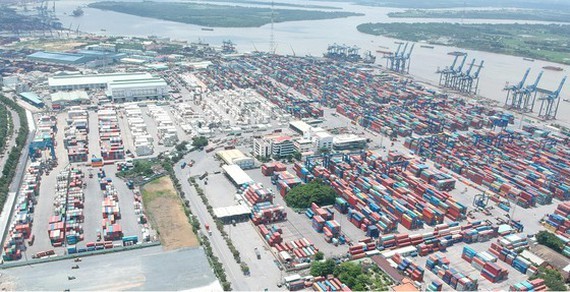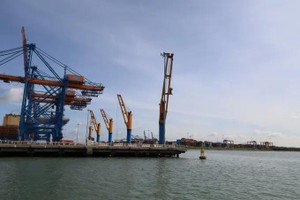
Last year, the Global Competitiveness Index of Vietnam climbed ten notches compared to that in 2018, ranking at the 67th place out of 141 economies.
Regarding the global business environment ranking, Vietnam's position increased from the 88th place out of 183 countries and territories in 2010 to the 70th place out of 190 countries and territories in 2019. Not only did the number of newly-established enterprises increase but the quality of them also improved significantly. Labor productivity has steadily increased over the years. Specifically, labor productivity rose by 5.3 percent over the previous year in 2016, 6 percent in 2017, 5.55 percent in 2018, and 6.28 percent in 2019.
However, this report stated that, in terms of the economic sector, the progress of equitization and divestment of State-owned enterprises was still slow compared to the plan; the performance of State-owned enterprises has not been commensurate with the allocated resources; the disbursement progress of public investment capital, as well as the efficiency of public investment, has not met the requirements. In the group of State-owned commercial banks, the restructuring faced difficulties in the regulations on additional capital supplementation; the restructuring progress of some non-bank financial institutions with major shareholders being state-owned corporations and corporations remained slow.
In terms of industry, the processing and manufacturing industries were still mainly operating in the low-end segment of the value chain; the internal industrial production capacity of the economy was limited and depended on foreign-invested enterprises. The private sector has not yet fulfilled its role as an important driving force of the economy. The operation of small and medium-sized enterprises still faced many difficulties due to the impacts of both objective and subjective factors, affecting the development, and limiting the scale and level of economic contribution.
Compared with other countries in the world, Vietnam’s small and medium-sized enterprises still had many limitations. Most of these businesses are service providers, and only about 20 percent of them are manufacturers. Up to 42 percent of enterprises have annual revenue of less than VND1 billion, and 85 percent of officially-operating enterprises have revenue below VND2 billion.
Although the number of private enterprises increases every year, the average size of each enterprise is not large. In Vietnam, there are currently nearly 100 million people and about 800,000 active enterprises, an average of about 130 people per enterprise while this rate in other countries in the ASEAN is over 80 people per enterprise. Labor productivity was still low and much lower than those of other countries in the region. Despite the above improvements, Vietnam's labor productivity in 2019 was only equal to 7.6 percent of Singapore, 19.5 percent of Malaysia, 37.9 percent of Thailand, 45.6 percent of Indonesia, 56.9 percent of the Philippines, and 6.89 percent of Brunei.
Regarding the global business environment ranking, Vietnam's position increased from the 88th place out of 183 countries and territories in 2010 to the 70th place out of 190 countries and territories in 2019. Not only did the number of newly-established enterprises increase but the quality of them also improved significantly. Labor productivity has steadily increased over the years. Specifically, labor productivity rose by 5.3 percent over the previous year in 2016, 6 percent in 2017, 5.55 percent in 2018, and 6.28 percent in 2019.
However, this report stated that, in terms of the economic sector, the progress of equitization and divestment of State-owned enterprises was still slow compared to the plan; the performance of State-owned enterprises has not been commensurate with the allocated resources; the disbursement progress of public investment capital, as well as the efficiency of public investment, has not met the requirements. In the group of State-owned commercial banks, the restructuring faced difficulties in the regulations on additional capital supplementation; the restructuring progress of some non-bank financial institutions with major shareholders being state-owned corporations and corporations remained slow.
In terms of industry, the processing and manufacturing industries were still mainly operating in the low-end segment of the value chain; the internal industrial production capacity of the economy was limited and depended on foreign-invested enterprises. The private sector has not yet fulfilled its role as an important driving force of the economy. The operation of small and medium-sized enterprises still faced many difficulties due to the impacts of both objective and subjective factors, affecting the development, and limiting the scale and level of economic contribution.
Compared with other countries in the world, Vietnam’s small and medium-sized enterprises still had many limitations. Most of these businesses are service providers, and only about 20 percent of them are manufacturers. Up to 42 percent of enterprises have annual revenue of less than VND1 billion, and 85 percent of officially-operating enterprises have revenue below VND2 billion.
Although the number of private enterprises increases every year, the average size of each enterprise is not large. In Vietnam, there are currently nearly 100 million people and about 800,000 active enterprises, an average of about 130 people per enterprise while this rate in other countries in the ASEAN is over 80 people per enterprise. Labor productivity was still low and much lower than those of other countries in the region. Despite the above improvements, Vietnam's labor productivity in 2019 was only equal to 7.6 percent of Singapore, 19.5 percent of Malaysia, 37.9 percent of Thailand, 45.6 percent of Indonesia, 56.9 percent of the Philippines, and 6.89 percent of Brunei.
























